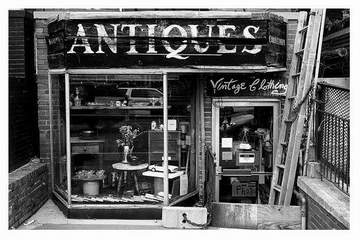Recently I have been going through a closet of mine and ran
across this lovely sculpture by Waylande Gregory for Cowan Pottery. I was
wondering if someone could tell me a good insurance value to place on this
piece.
The "Beaten Dog" by Waylande Gregory; is based on
a stray dog that the artist tried to nurse back to health, and it's believed
that there are only three in existence. (The Cleveland Museum of Art and
Western Reserve Historical Society each have one.) This find would bring the
count to four.
One piece of Cowan Pottery that any collector would snatch
up if money were no object is the famous "Jazz Bowl" by Viktor
Schreckengost. Experts believe that there are about 50 bowls in existence with
three different designs. In December of 2004, one of the bowls went for more
than $250,000 at Sotheby's auction house. Being that there are only four of
these dog's accounted for, I have a feeling that this piece may surpass the
value of the "Jazz Bowl".
I have contacted Carol
Jacobs who is the Curator of the Cowan Pottery Museum who
stated the following in correspondence:
"According
to the "Bible" of Cowan Pottery, Cowan Pottery and the Cleveland
Schoolby Mark Bassett & Victoria Naumann
(1997), the Beaten Dog was Gregory's most important animal sculpture. It was
based on a stray dog that he owned and tried, unsuccessfully, to nourish back
to health. It was created ca. 1931, and in fact won first place in ceramic
sculpture at the Cleveland Museum of Art's annual May
Show in 1931. It's original name was "The Waif," but it came to be
known as "The Beaten Dog." I do not have any recent auction figures,
so cannot give you any idea of valuation. But I do know that it is a fairly
rare piece, and probably has significant value."
I have also contacted Mark Bassett
who expressed interested in purchasing the piece and
therefore would not be the appropriate person to ask about values.
Some information about
the artist:
Waylande
Desantis Gregory (1905 Baxter Springs, Kansas – 1971, New Jersey)
was one of the most innovative and prolific American art-deco ceramics
sculptors of the early twentieth century. His groundbreaking techniques enabled
him to create monumental ceramic sculpture, such as the Fountain of the
Atoms and Light Dispelling Darkness, which had hitherto not been
possible. He was also an early seminal figure in the studio glass movement.
Waylande
Gregory is one of the most influential ceramic sculptors of the 20th century,
who had helped to shape the Art Deco period in America. Artistically, he had
developed much of the art-deco sculptural visual vocabulary in American art. In
one of his more notable pieces, Salome, the horror of the decapitated
St. John the Baptist is secondary to the lyricism of the near linear rhythm of
Salome’s dance of the seven veils, expressive of pure form and motion. He
combines both the erotic dance of the seven veils simultaneously with the
decapitated head of St. John on a silver platter. Unlike his contemporaries at
Cowan studios who followed in the footsteps of Austrian modern pottery
exemplified by the Wiener Werkstätte, Waylande Gregory sought to create a
distinctly American form, for instance, his second sculpture of Henry Fonda,
capturing in essence what he felt were the best American traits.
Technically,
his most direct contributions include development of methods for the creation
of monumental ceramic sculptural works, and the development of revolutionary
glazing and processing methods. After he had moved to New Jersey and begun to
work with the large kilns at Atlantic Terra Cotta, he began to develop new
techniques which made monumental ceramic sculpture possible. Prior to Waylande
Gregory, ceramic sculpture was limited in size due to the tendency for clay to
slump after being formed without being supported by an armature of metal or
wood. Other methods included sculpting the entire piece in clay and then going
back and hollowing out the clay on the inside. This would lead to problems with
sagging during firing, and tendency to crack. As a result, there were many
limitations to the prior two techniques. By using a honeycomb method of
building up the ceramic sculpture from the inside out, similar to the way that
wasps build up their nests, he was able to form the sculpture as a
self-supporting whole prior to firing, and his sculptures would go through the
firing process successfully without cracking. Unlike other ceramicists, who
would fire the sculpture to bisque, and then glaze, he would form, glaze and
then fire the sculpture only once for the finished art work.
He never used
factory-made glazes, grinding and mixing all of the glazes himself, carefully
controlling firing temperatures as well as kiln atmosphere to achieve the
effects that he desired. Among his innovations are compressing of glaze powder
into a crayon for sfograffito, and a patented process for fusing glass and
ceramic together in a crackle pattern
Any help identifying a value on this
piece would be greatly appreciated.







